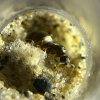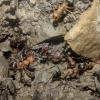- Formiculture.com
- Forums
- Gallery
- Members
- Member Map
- Chat

Formica vs Camponotus ID by eyeballing.
Started By
michiganantsinmyyard
, Jul 8 2024 4:59 PM
7 replies to this topic
#1
 Offline
-
Posted July 8 2024 - 4:59 PM
Offline
-
Posted July 8 2024 - 4:59 PM
How do you separate Formica from Camponotus through simple eyeballing? Of course, some species of Camponotus have majors, plus it’s easier to tell the species by breaking into a nest full of them, but if I were walking, and just a couple, or one worker was walking by, is there a way I could quickly tell without good eyes or a microscope that it is Formica or Camponotus?
#2
 Offline
-
Posted July 8 2024 - 5:10 PM
Offline
-
Posted July 8 2024 - 5:10 PM
The thoracic dorsum of Camponotus forms an even curve. The thoracic dorsum of Formica is interrupted by a depressed mesonotal juncture and the mesonotum is typically slightly raised.
- gcsnelling, ZTYguy and UtahAnts like this
#3
 Offline
-
Posted July 8 2024 - 6:27 PM
Offline
-
Posted July 8 2024 - 6:27 PM
Formica usually move in much faster, erratic spurts than Camponotus.
- UtahAnts and cooIboyJ like this
"The ants are a people not strong, yet they prepare their meat in the summer." Prov. 30:25
Keep ordinary ants in extraordinary ways.
Keep ordinary ants in extraordinary ways.
#4
 Offline
-
Posted July 9 2024 - 3:32 PM
Offline
-
Posted July 9 2024 - 3:32 PM
Formica have smaller heads but this isn't always true
#5
 Offline
-
Posted July 9 2024 - 4:02 PM
Offline
-
Posted July 9 2024 - 4:02 PM
Formica are usually way faster, more erratic in movement, and they don't have big-headed majors to the same extent as most Camponotus do. Look for majors to differentiate. Also I heard that Formica have the most advanced aphid-tending strategies, so if you see lots of ants moving, guarding, and transporting aphids/honeydew around, it's probably formica. Also I noticed that, at least the colonies I have around my house, Formica forms mounds of sand where they dig, but the mounds are pretty flat and wide, while Camponotus doesn't really do this, unless in wood, in which case they form shorter, taller mounds of wood shavings. However, this is only what I've seen in my area, and is likely not the same everywhere. Finally, if you see some species forming huge nests out of twigs and suchlike, it's formica obscuripes. Just so you know, haha.
Currently raising:
Myrmica Rubra (1 queen + ~5 workers)
Lasius Niger (single queen + ~90+ workers)
Lasius Neoniger (two single queen + brood)
Formica spp. (Queen [likely parasitic, needs brood])
Also keeping a friend's tetramorium immigrans for the foreseeable future. Thanks CoffeBlock!
#6
 Online
-
Posted July 10 2024 - 9:25 AM
Online
-
Posted July 10 2024 - 9:25 AM
The thoracic dorsum of Camponotus forms an even curve. The thoracic dorsum of Formica is interrupted by a depressed mesonotal juncture and the mesonotum is typically slightly raised.
And it is simple as that, at least in the U.S.
- ZTYguy and ReignofRage like this
#7
 Offline
-
Posted July 10 2024 - 12:03 PM
Offline
-
Posted July 10 2024 - 12:03 PM

Note that Camponotus start to look the more like Formica the further south you go.
- gcsnelling, rptraut and Stubyvast like this
We should respect all forms of consciousness. The body is just a vessel, a mere hull.
Welcome to Lazy Tube - My Camponotus Journal
#8
 Offline
-
Posted July 11 2024 - 4:34 PM
Offline
-
Posted July 11 2024 - 4:34 PM
Yah up in BC, completely different. you can just tell by eyeballing it.
Currently raising:
Myrmica Rubra (1 queen + ~5 workers)
Lasius Niger (single queen + ~90+ workers)
Lasius Neoniger (two single queen + brood)
Formica spp. (Queen [likely parasitic, needs brood])
Also keeping a friend's tetramorium immigrans for the foreseeable future. Thanks CoffeBlock!
3 user(s) are reading this topic
0 members, 3 guests, 0 anonymous users

















